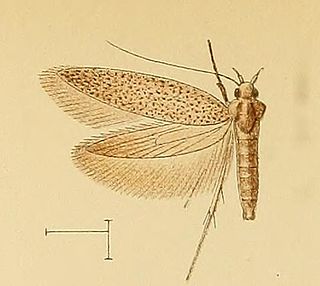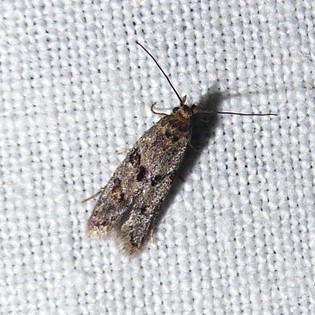Torodora is a genus of moths in the family Lecithoceridae. The genus was erected by Edward Meyrick in 1894.

Agnathosia is a genus of moths belonging to the family Tineidae.

Infurcitinea is a genus of the fungus moth family, Tineidae. Therein, it belongs to the Meessiinae, one of the larger fungus moth subfamilies.
Crypsithyris is a genus of moths belonging to the family Tineidae.
Tineomigma is a genus of moths belonging to the family Tineidae.
Praeacedes is a monotypic moth genus in the family Tineidae first described by Hans Georg Amsel in 1954. Its only species, Praeacedes atomosella, was first described by Francis Walker in 1863. It has a wide range and has been recorded from Europe, Australia, Hawaii, India, Malaysia, Solomon Islands, Easter Island, Mauritius, Madagascar, Réunion, South America and North America. The species has commonly been misidentified in various parts of the world.

Aphomia sabella, the greater date moth, is a species of snout moth in the genus Aphomia. It was described by George Hampson in 1901 and is known from the Persian Gulf, Algeria and Iran. It was first recorded in Spain in 1999.
Homoeosoma stenotea is a species of snout moth in the genus Homoeosoma. It was described by George Hampson in 1926. It is found in Zimbabwe, Madagascar, Mozambique, Lesotho and South Africa as well as from the Canary Islands and Morocco.
Ancylolomia tripolitella is a species of moth in the family Crambidae described by Hans Rebel in 1909. It is found in Spain and on Sardinia, Malta, and the Canary Islands, in Iran, and in Algeria, Libya, Syria, Jordan and Bahrain.

Chersogenes canariensis is a species of moth in the family Autostichidae. It is found on the Canary Islands.

Chersogenes sophroniellus is a species of moth in the family Autostichidae. It is found on the Canary Islands.

Chersogenes brachyptera is a species of moth in the family Symmocidae. It is found on the Canary Islands.
Chersogenes eupracta is a species of moth in the family Autostichidae. It is found on the Canary Islands.

Apatema is a moth genus in the family Autostichidae.

Chersogenes is a genus of moths in the family Autostichidae.
Chersogenes arenbergerorum is a species of moth in the family Autostichidae. It was described by László Anthony Gozmány in 1988. It is found in Tunisia.
Chersogenes enigmatica is a species of moth in the family Autostichidae. It was described by László Anthony Gozmány in 1964. It is found in Algeria.
Chersogenes friedeli is a species of moth in the family Autostichidae. It was described by László Anthony Gozmány in 1988. It is found in Morocco.
Chersogenes tunesica is a species of moth in the family Autostichidae. It was described by László Anthony Gozmány in 1988. It is found in Tunisia.
Pantacordis klimeschi is a moth in the family Autostichidae. It was described by László Anthony Gozmány in 1957. It is found on Sicily.






